Camping in Thunderstorms: Tips and Equipment
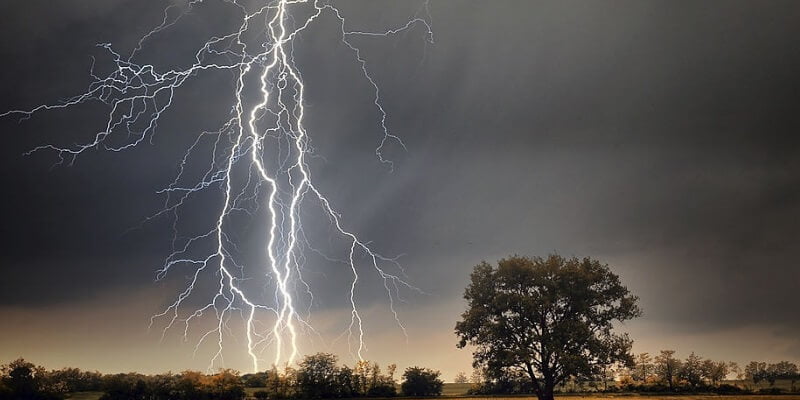
Camping during a thunderstorm can be an exhilarating adventure, but it also carries risks for outdoor fans. The atmosphere crackles with energy as strong winds whip through the trees and rain cascades down, transforming your campsite into a dramatic natural theater. Although the thunder rumbles and lightning dances across the sky, the challenge lies in staying safe.
In this guide, we’ll explore how to embrace the storm while protecting yourself and your gear. We’ll share tips on what to watch for, essential equipment to have on hand, and behaviors that can turn a stormy night into a breathtaking experience—one that you’ll reminisce about for years to come.
10 Basic Tips for Camping In Thunderstorms!
Let’s see 10 pro tips for camping in thunderstorms step by step…
1. Recognize the danger in good time
Before heading out, check the weather forecast for where you plan to camp. If thunderstorms are predicted, consider postponing your trip or choosing a safer location. Apps such as the warning weather app let you know when a storm is approaching your campsite. If the distance between lightning and thunder is less than 10 seconds, the risk of a lightning strike in your area is very high. The danger is over only 30 minutes after the last thunder.
2. Go to shelters
When a thunderstorm looms on the horizon, your safety should be your top priority. Seek refuge in a sturdy building equipped with a lightning rod or hop into a closed car. The metallic body of a vehicle acts as a Faraday cage, protecting everyone inside. If shelter isn’t accessible, your best bet is to find a low-lying area away from tall objects like trees or cliffs, as lightning is more likely to strike higher surfaces.
3. Avoid raised and open areas
That’s why seeking shelter near sturdy building walls, high-voltage lines, large festival tents, metal flagpoles, and rock walls can provide an extra layer of safety from lightning strikes. However, it’s crucial to maintain a distance of at least three feet from these structures to avoid the risk of a lightning bolt jumping toward you. During a thunderstorm, it’s essential to steer clear of open fields, hilltops, and bodies of water, as these areas are more likely to attract lightning.
4. Keep away from individual tree
Lightning strikes can turn trees into explosive hazards! When a bolt of lightning hits a tree, it can cause the trunk to splinter and bark to fly, making it essential to keep a safe distance of at least 10 meters. Isolated trees are particularly vulnerable to strikes, so it’s best to steer clear of them. However, if you find yourself in a forest with trees of similar height, you’re in a much safer spot.
5. Minimize contact with the ground
When lightning strikes, electricity can travel through the ground, creating a dangerous ripple effect. To reduce your risk during a thunderstorm, minimize your contact with the ground by keeping your feet close together. This stance helps limit the electrical flow that could affect you. It’s also crucial to avoid touching anyone else nearby, as this can create a pathway for the electricity to spread.
6. Use a quality tent to protect against wind and rain
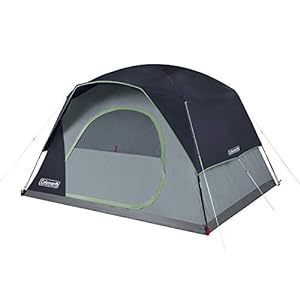
A normal tent does not block lightning but protects you from wind, rain and cold. If no lightning-protected room is available, crouch on a non-conductive surface in the middle of your tent. For example, a dry air mattress or sit on a backpack and keep your feet close together here too.
7. Bring the right equipment
With sturdy stakes that are suitable for the ground under your tent, you can tension the tent and make it windproof. Secure your pavilion from thunderstorms with storm lines. Don’t hold him by lightning and thunder! After a thunderstorm, you can quickly repair damage to your tent with a repair kit.
8. Choose a good location for your tent
Do not pitch your tent on a hill or near solitary, tall trees. Small sinks are not good either: They quickly fill up with water in heavy rain. A slight slope is better, on the side facing away from the wind. The tent’s entrance points away from the wind.
9. Don’t be a lightning magnet
If lightning-protected rooms and your tent are not within reach, do not be at the highest point in the area yourself. Avoid hills, get off your bike, and get off your umbrella! The best thing to do is to crouch in a depression with your feet together and pull your head in.
10. Avoid water activities
Water is a good conductor of electricity. If lightning strikes a body of water, the electrical current can travel through the water, potentially posing a danger to anyone in or near the water. Boats, especially those with metal components, are at a higher risk during a thunderstorm. Swimmers are also at risk due to their proximity to the water’s surface. So avoid swimming or boating during a thunderstorm.
Basic Equipment for Camping in Thunderstorms
In the following sections, we’ll explore the specific equipment you should consider bringing on a camping trip where thunderstorms are a possibility.
Robust tent pegs
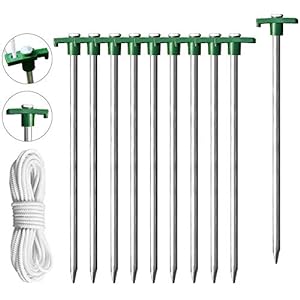
Eurmax Galvanized Tent Stakes are made of solid steel and withstand tensile forces in strong winds without bending or breaking. Because of the T-shaped handle, the storm line holds even if the peg turns in the ground. The round cross-section makes it easier to hammer into hard and stony soils. If the ground is softened by rain, the screw thread improves the hold. The order also includes bonus 4’10” Ropes and 1 Green Stopper.
Groundsheet
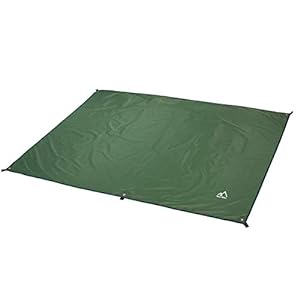
An additional groundsheet protects your tent floor from sharp objects such as branches and small stones. This prevents water from entering the tent from below. Groundsheet also improves the insulation against ground currents in the event of lightning strikes. Because the tent is not in the mud, cleaning up after the storm is made easier. We recommend the fabric Hiker Camping Tarpaulin from Terra, one of the more stable tarpaulins with reinforced edges.
IOS or Android Apps

The app from the weather service warns you of impending storms and natural hazards such as floods and storm surges. The app is available free of charge from Google Play and the Apple App Store. AccuWeather is known for its reliable and accurate weather forecasts. The app can provide timely alerts for thunderstorms in your area. This early warning can give you valuable time to prepare, seek shelter, or even consider adjusting your camping plans if necessary.
Seam sealer

If the seams of your tent have become leaky after a violent storm, you can easily seal them with a seam sealer. Small cracks and holes in the tarpaulin, the tent floor, air mattresses, and shoes can also be repaired in this way. For PU tents, we recommend the proven GEAR AID Seam Grip TF Tent Fabric Sealer, which is simply applied to the inside of the damaged area.
Guy ropes
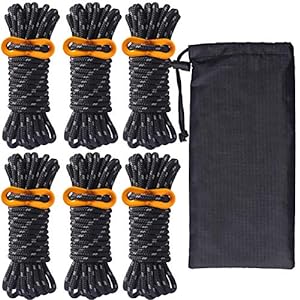
Standing outside during a thunderstorm and holding the iron bar of the pavilion in your hand with your arms stretched out – that’s pretty much the most dangerous thing you can do during a thunderstorm. It is better to secure your pavilion in good time before the storm.
Hikeman Guy Lines Tent Cords Rope consists of 6 guy ropes, each 4 meters long. It comes with pre-assembled three-hole tensioners and peg loops. That makes tensioning quick and easy.
Frequently Asked Questions
Can I stay in my tent during a thunderstorm?
Although a tent offers some protection from rain, it’s not safe during a thunderstorm, especially due to the risk of lightning. If you must stay in your tent, position yourself on non-conductive materials, and keep low to the ground.
How can I prepare my campsite before a storm arrives?
Before a storm hits, secure all loose gear, and ensure your tent is properly anchored with sturdy stakes and guy lines. Clear any debris that could become hazardous during high winds, and position your tent in a location that avoids flooding and falling branches.
How do I identify signs of an approaching storm?
Watch for darkening skies, sudden changes in wind direction, and an increase in humidity. Listen for thunder, and pay attention to local weather apps for alerts.
Is it safe to use my electronic devices during a thunderstorm?
Avoid using electronic devices that are plugged into electrical outlets or charging. If you must use your devices, do so only when you are in a safe location away from potential lightning strikes.
What first-aid items should I pack for a thunderstorm camping trip?
Include a first-aid kit with bandages, antiseptic wipes, pain relievers, and any personal medications. Pack items for treating potential injuries from storms, such as splinters or falls, and ensure you have a means to call for help if needed.
How can I keep my spirits up during a storm while camping?
Embrace the adventure! Bring along games, a book, or storytelling materials to pass the time. If safe, enjoy the sound of rain and thunder from your shelter, and take the opportunity to appreciate the beauty of nature’s power.
Conclusion
Camping in thunderstorms offers a unique opportunity to experience the raw power of nature. We’ve explored the key tips and necessary equipment for safe camping during thunderstorms. If you follow this strategy, you can turn a potentially hazardous situation into a memorable adventure. Stay informed about the weather to adapt to changing conditions. Happy camping!





